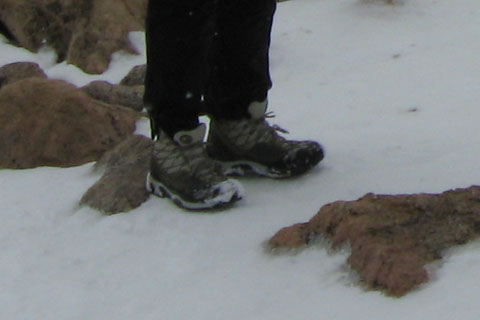| 642 | Trail Sense Blisters |
2012-05-14 |

On the approach hike to Mount Robson in the Canadian Rockies, a friend of mine was wearing large leather mountaineering boots and carrying a heavy pack. As he worked his way up the trail, the heavy pack took it's toll. Sweat rolled down his legs soaking his socks. He changed his gait to try and ease some of the load of the pack. Soon he was walking with a noticeable limp. I didn't think much about the limp, but assumed it was caused by carrying the heavier than normal pack. We were all struggling.
When we finally arrived at Berg Lake, my friend took off his boots to cross a stream. He had huge blisters on both heels. I had never seen blisters like those before - they were at least three skin layers deep and bleeding. Our trip was three weeks long, but he was crippled for the remainder of the time. I think he gave the boots away.
Perhaps as we were walking, I should have asked him about his unusual gait, but he was an adult and I assumed was capable of taking care of himself. He did admit that he thought he might have had hot spots or small blisters on each heel, but had no idea as to the extent of the sores. He had never had trouble with blisters before.
Our vacations are too precious to spend them sidelined because of blisters.
A few causes of blisters ...
- new footwear - shoes or boots that are not broken in (meaning the boots do not break where the foot bends)
- old footwear - shoes that have lost material in their heel or have worn the soles to the point that they change your gait
- stiff footwear - shoes that do not bend, your heel has to move up and down to walk - friction is inevitable
- heavy footwear - any shoes that change your gait subject you to blisters
- footwear that is too large - leaves your heel with room to slide up and down
- boots that are too small - kills you toes
- wearing too many socks - makes the shoes not fit and also leads to the socks bunching
- not having enough socks - socks help provide cushioning and help boots fit - with the wrong socks the fit is bad
- type of socks - some people have trouble with blistering, especially when wearing wool socks
- heavy packs - alter the way we walk and lead to blisters
A few prevention tips ...
Rubbing alcohol toughens up your feet. Use it before a trip begins.
Make sure your shoes fit before the trip starts. Every time I have used an untested pair of shoes on a trip, I think I have gotten a blister.
Break the shoes in before the trip.
Test different sock combos with your shoes.
If you are wearing running shoes (or other flexible shoes) you should size the shoes - large. You should not get a heel blister as long as the shoes are flexible, but your foot might slide into the toe box - so size them large enough to keep your toes from banging into the toe box.
There are many blister prevention products on the market. We use Sports Slick, Body Glide, and Hydropel. Hydropel is by far the slickest.
We have had good success with all three anti-friction products.
Some hikers use duct tape to reduce friction. The same hikers also use duct tape to treat the sore. Cut a small circle of tape and stick it glue side to glue side to the covering tape. Place the non-sticky section over the sore.
Use Tincture of Benzoin to help hold the tape in place. It really helps, but it is just another thing to bring.
Stop when you get a hot spot and check your feet. This is sometimes hard when you are with a group, but it is important. The others should understand.
We like New Skin antiseptic (but you still need to protect the sore).
When it is really hot, take your shoes off and air your feet out when you stop to take a break.
Re-lace your shoes for a better fit - matching the terrain.
I have never found a universal formula for blister prevention. What works well for one person might not work as well for others.
If, you get a blister, then you will probably be forced to sit and listen to lots of advice from your hiking partners. You deserve it. You are the one who got the blister, so just smile. Maybe some of the suggestions will work.
Happy no blister trails